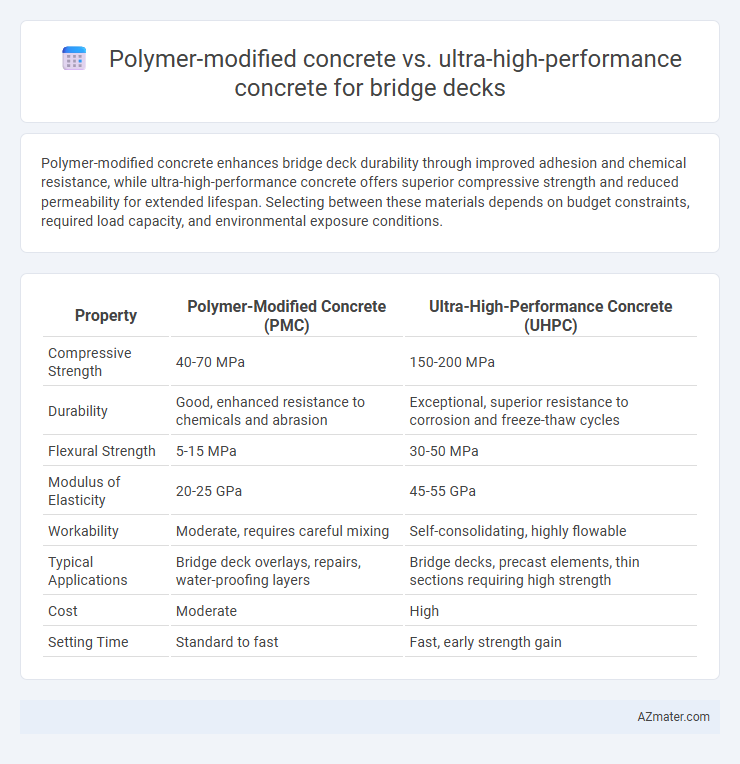Polymer-modified concrete enhances bridge deck durability through improved adhesion and chemical resistance, while ultra-high-performance concrete offers superior compressive strength and reduced permeability for extended lifespan. Selecting between these materials depends on budget constraints, required load capacity, and environmental exposure conditions.
Table of Comparison
| Property | Polymer-Modified Concrete (PMC) | Ultra-High-Performance Concrete (UHPC) |
|---|---|---|
| Compressive Strength | 40-70 MPa | 150-200 MPa |
| Durability | Good, enhanced resistance to chemicals and abrasion | Exceptional, superior resistance to corrosion and freeze-thaw cycles |
| Flexural Strength | 5-15 MPa | 30-50 MPa |
| Modulus of Elasticity | 20-25 GPa | 45-55 GPa |
| Workability | Moderate, requires careful mixing | Self-consolidating, highly flowable |
| Typical Applications | Bridge deck overlays, repairs, water-proofing layers | Bridge decks, precast elements, thin sections requiring high strength |
| Cost | Moderate | High |
| Setting Time | Standard to fast | Fast, early strength gain |
Introduction to Advanced Concrete Technologies
Polymer-modified concrete (PMC) enhances traditional concrete with polymers to improve durability, flexibility, and resistance to cracking, making it suitable for bridge decks exposed to harsh environmental conditions. Ultra-high-performance concrete (UHPC) offers superior strength, toughness, and longevity due to its optimized particle packing and fiber reinforcement, enabling thinner, lighter, and more resilient bridge decks. Both technologies represent advancements in concrete materials aimed at extending bridge lifespan, reducing maintenance costs, and improving structural performance under high traffic loads and extreme weather.
Understanding Polymer-Modified Concrete (PMC)
Polymer-modified concrete (PMC) enhances traditional concrete by incorporating polymers, which improve adhesion, flexibility, and resistance to chemical attack and abrasion, making it suitable for bridge decks exposed to harsh environments. PMC offers better crack resistance and durability compared to conventional concrete, facilitating longer service life and reduced maintenance costs. Its ability to bond with existing structures and accommodate slight movements ensures improved performance in bridge deck applications where structural integrity and longevity are critical.
Key Features of Ultra-High-Performance Concrete (UHPC)
Ultra-high-performance concrete (UHPC) offers exceptional compressive strength exceeding 150 MPa and unparalleled durability, making it ideal for bridge decks subjected to heavy traffic and harsh environmental conditions. Its dense microstructure and steel fiber reinforcement provide superior abrasion resistance and significantly reduce permeability, enhancing longevity and resistance to chloride-induced corrosion. Compared to polymer-modified concrete, UHPC delivers a longer service life with reduced maintenance, optimizing lifecycle costs and structural performance in demanding bridge applications.
Durability Comparison: PMC vs UHPC in Bridge Decks
Polymer-modified concrete (PMC) enhances durability in bridge decks by improving resistance to chloride penetration and freeze-thaw cycles, reducing cracking and extending service life. Ultra-high-performance concrete (UHPC) offers superior durability with its dense microstructure, exceptional abrasion resistance, and higher compressive strength, resulting in significantly lower permeability and enhanced resilience against environmental factors. Studies indicate UHPC outperforms PMC in long-term durability, making it the preferred choice for critical bridge deck applications subject to heavy traffic and aggressive exposure conditions.
Strength and Load-Bearing Capacities
Polymer-modified concrete (PMC) significantly enhances flexural strength and durability in bridge decks by improving bond adhesion and reducing permeability, leading to greater load-bearing capacity under cyclic loads. Ultra-high-performance concrete (UHPC) exhibits compressive strengths exceeding 150 MPa and tensile strengths above 10 MPa due to optimized particle packing and fiber reinforcement, providing superior structural resilience and fatigue resistance in demanding bridge applications. UHPC's higher modulus of elasticity and improved toughness outperform PMC in long-term load-bearing capacity, making it ideal for critical bridge deck segments subjected to heavy traffic and dynamic stresses.
Workability and Constructability Considerations
Polymer-modified concrete (PMC) enhances bridge deck workability through improved slump retention and reduced segregation, facilitating easier placement and finishing in varying weather conditions. Ultra-high-performance concrete (UHPC) offers superior constructability by providing exceptional flowability and self-consolidation, minimizing the need for vibration and reducing labor intensity. Both materials improve durability, but UHPC's dense matrix and rapid strength gain enable accelerated bridge deck construction schedules while maintaining long-term performance.
Cost Analysis: Initial Investment and Lifecycle Costs
Polymer-modified concrete (PMC) typically involves a lower initial investment compared to ultra-high-performance concrete (UHPC) due to less expensive raw materials and simpler manufacturing processes. UHPC offers superior durability and reduced maintenance costs, which can significantly lower lifecycle expenses despite its higher upfront price. For bridge decks, a comprehensive cost analysis must weigh PMC's affordability against UHPC's extended service life and reduced repair frequency to optimize long-term economic benefits.
Maintenance Needs and Longevity
Polymer-modified concrete (PMC) enhances durability and reduces permeability, leading to lower maintenance needs and improved resistance to cracking on bridge decks compared to conventional concrete. Ultra-high-performance concrete (UHPC) offers superior compressive strength and exceptional durability, resulting in significantly extended service life and minimal repair requirements under heavy traffic and harsh environmental conditions. The longevity of UHPC outperforms PMC by providing enhanced resistance to freeze-thaw cycles, chloride ingress, and abrasion, making it a preferred choice for bridge decks requiring long-term performance with reduced lifecycle costs.
Environmental Impact and Sustainability
Polymer-modified concrete (PMC) enhances durability and reduces maintenance needs in bridge decks, decreasing resource consumption over the structure's lifespan. Ultra-high-performance concrete (UHPC) provides superior strength and longevity, allowing for thinner decks and less material use, significantly lowering carbon emissions associated with production. Both options contribute to sustainability, with UHPC's longer service life offering greater environmental benefits despite higher initial embodied energy compared to PMC.
Case Studies: PMC vs UHPC in Real-World Bridge Projects
Case studies of bridge decks using Polymer-Modified Concrete (PMC) reveal enhanced durability and resistance to chloride penetration, significantly extending service life in coastal and heavy traffic environments. Ultra-High-Performance Concrete (UHPC) projects demonstrate superior mechanical properties, achieving 150-200 MPa compressive strengths and exceptional crack control, which translates to reduced maintenance and thinner deck designs. Comparative analysis highlights UHPC's higher initial cost offset by long-term savings, while PMC offers a cost-effective balance of performance and ease of application in moderate stress conditions.

Infographic: Polymer-modified concrete vs Ultra-high-performance concrete for Bridge deck
 azmater.com
azmater.com